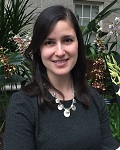2019
Talia Bess Shabtay
- Doctoral Candidate
- Northwestern University

Abstract
This dissertation examines visual practice at the intersection of art and science in the United States during the early Cold War. It focuses on artists and scientists who utilized or invented new technologies for seeing the world beyond the limits of the unarmed human eye. From artist Berenice Abbott’s macro-photographic apparatus for Supersight to mathematician Benoit Mandelbrot’s use of early computer graphics to invent a new form of geometry, it looks at how machine-assisted seeing restructured vision in America during a cold and invisible war. In attending to the emergent interface between the human eye and the machine between 1946 and 1961, the project reframes twentieth-century art historical debates about opticality, scale, and the human body. Key analyses of photographs, design objects, and visual models offer a new set of terms for evaluating the nexus of mid-twentieth-century American art and American vision.

